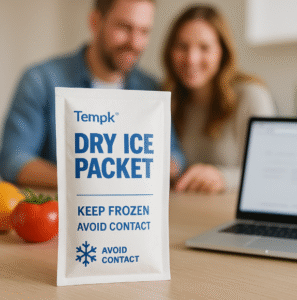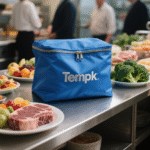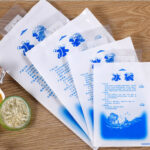Quick Takeaways
-
Retail: $2–$4/lb; Bulk/Contract: $0.60–$1.20/lb (location & season dependent)
-
Primary cost drivers: order volume, geography, dry ice form, compliance, embalaje, and storage losses
-
Alternatives: PCM phase-change packs o paquetes de gel can reduce dry ice usage for certain routes and temperature profiles

1. Pricing Fundamentals: Cómo Hielo seco Is Sold
Dry ice is priced by weight (per pound or kilogram). El unit price decreases with larger volumes due to economies of scale. While form (bandear, blocks, pre-packed units) influences price slightly, the dominant factor is weight and total order size.
Ejemplo:
-
1–5 lbs retail: $2–$4/lb
-
50 libras: ~$1.50/lb
-
500 libras: ~$0.80/lb under wholesale terms
2. Six Key Factors Influencing Price
-
Order Volume – Bulk contracts with tiered pricing deliver the lowest unit costs.
-
Geography & Transport Distance – Sourcing near production reduces freight and sublimation losses.
-
Form & Embalaje – Pellets may cost slightly more than blocks; pre-filled insulated packs command a premium but extend holding time.
-
Compliance & Handling Fees – Air freight hazardous materials surcharges (IATA PI 954) increase total cost.
-
Monitoreo de temperatura – Built-in data loggers improve shipment reliability but add to per-unit cost.
-
Loss Rate (Sublimation) – Daily losses of 5–10% are common; better insulation or just-in-time delivery lowers effective cost.
3. Typical Price Tiers (2025)
| Order Volume | Approx. Price (USD/lb) | Total Cost Example | Use Case | Notes |
|---|---|---|---|---|
| 10 libras | ~$2.00 | ~$20 | Urgent/small shipments | Baseline retail rate |
| 50 libras | ~$1.50 | ~$75 | Scheduled distribution | ~25% per-lb savings |
| 500 libras | ~$0.80 | ~$400 | High-frequency shippers | Near wholesale pricing |
4. Hielo seco vs. PCM vs. Paquetes de gel
| Cooling Medium | Typical Price Range* | Optimal Temp/Duration | Aplicaciones | Cost Advantage |
|---|---|---|---|---|
| Hielo seco | $1.50–$3.00 retail; $0.60–$1.20 bulk | −78 °C, short-to-mid haul | Farmacéutico, biotecnología, frozen food | Best for ultra-low temps |
| PCM Packs | $0.80–$2.50 | −25 °C to −18 °C, mid-to-long haul | Frozen/chilled goods | Extended duration, reutilizable |
| Paquetes de gel | $0.30–$1.00 | 0–8 °C or −5–0 °C | Light cold chain | Lowest cost per unit |
*Based on aggregated 2025 supplier data; actual rates vary by region and vendor.
5. Market Trends & Outlook (2025)
-
Demand Growth – Driven by e-commerce fresh food, global pharma, and biotech logistics
-
Supply Stabilization – Post-2022 CO₂ shortages addressed via diversified feedstock and new production capacity
-
Sustainability Innovations – CO₂ capture/recycling reduces production cost up to 40%, supporting stable prices
-
Hybrid Cooling Solutions – Strategic use of PCM/gel packs to offset dry ice consumption
6. Procurement Channels
-
Local Retail (p.ej., supermercados) – Immediate access, highest per-lb cost
-
Specialized Industrial Suppliers – Scheduled delivery, bulk discounts, custom packaging
-
Contract Procurement – Ideal for high-frequency lanes; stable pricing & guaranteed capacity
7. Twelve Proven Cost-Reduction Tactics
-
Consolidate orders to access tiered pricing
-
Source locally to cut freight and loss
-
Match form to route length (pellets for short, blocks for long)
-
Upgrade insulation to extend hold time
-
Optimize pack-out to reduce air gaps
-
Minimize transit time and re-openings
-
Integrate temperature data logging to avoid over-packing
-
Avoid over-buying; plan just-in-time
-
Combine dry ice with PCM or gel packs
-
Maintain dual suppliers for price resilience
-
Train handlers to minimize waste and safety incidents
-
Track total landed cost (unit price + freight + loss + re-icing) regularly
8. Preguntas frecuentes
Q1: What is the typical per-pound price in 2025?
A: $2–$4/lb retail; $0.60–$1.20/lb for bulk/contract buyers.
Q2: Is bulk purchase more economical?
A: Sí. Volume discounts can reduce unit cost by over 60% versus retail.
Q3: Can I ship dry ice internationally?
A: Sí, but comply with IATA PI 954 and hazardous goods handling rules; expect additional charges.
Q4: How to reduce dry ice without risking product integrity?
A: Improve insulation, shorten transit, and combine with PCM or gel packs.
9. Acerca de Tempk
Tempk delivers paquetes de hielo seco, PCM solutions, and insulated packaging to food, farmacéutico, and biotech shippers. We offer bulk pricing, tailored insulation systems, and temperature-monitoring integration to optimize cold chain performance and cost efficiency.























